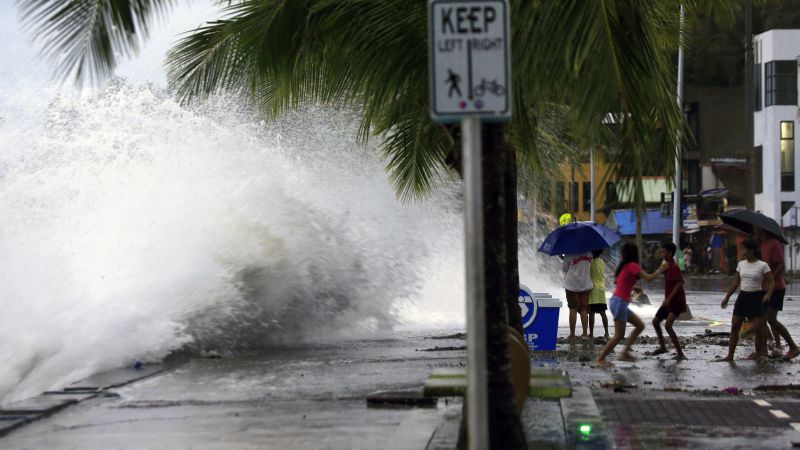Headline: Super Typhoon Man-yi Strikes Philippines, Prompting Mass Evacuations
As Super Typhoon Man-yi tore through the eastern coast of Catanduanes on Saturday, over 500,000 residents have been forced to evacuate their homes, marking one of the most significant emergency responses in recent history for the Bicol region of the Philippines. With winds reaching up to 160 mph (260 kph), this storm has intensified rapidly, drawing comparisons to a Category 5 hurricane and raising concerns about catastrophic impacts not just on local communities but also on regional technology infrastructures.
A Rapidly Intensifying Threat
The Philippine Atmospheric, Geophysical and Astronomical Services Administration (PAGASA) issued Signal 5 warnings for the affected areas—an indication of the highest level of alert. What makes this storm especially concerning is its rapid intensification. Man-yi transitioned from a tropical storm to a super typhoon in a just over 24 hours, gaining 55 mph in wind speed, well above the threshold of 35 mph defined as rapid intensification.
According to the nation’s disaster officials, mandatory evacuations were enacted in the Northern Samar province, where at least 26,000 individuals were relocated to safety from Friday into Saturday. Approximately 18,000 additional residents were preemptively moved from the Eastern Samar and Samar provinces, with staff and patients from the Arteche District Hospital being relocated to municipal hall facilities.
Impacts on The Ground
The effects of Super Typhoon Man-yi have already begun to materialize, with widespread reports of damaging winds, expected severe flooding, and landslides across the region. In a heartfelt appeal on social media, Catanduanes Governor Joseph Boboy Cua expressed the urgent need for prayers and assistance, stating, “Most importantly, we pray you do not forget about Catanduanes. We appeal for your power restoration teams, free calls and text booths, in-kind donations, help and attention, especially after the typhoon leaves the country,” as reported by the Philippine News Agency (PNA).
As the storm moves across the archipelago, it is anticipated to make landfall again approximately 70 miles (110 km) northeast of Manila on Sunday afternoon, with forecasts indicating several meters of potentially catastrophic storm surges. This imminent danger has raised additional alarms regarding the stability of emergency services and the technology infrastructure that supports communications and response efforts in the area.
Potential Impact on Technology and Communication
In the wake of natural disasters, technology plays a crucial role in response and recovery efforts. Disruptions caused by Super Typhoon Man-yi can lead to significant challenges in communication systems. This storm threatens both the public’s ability to stay informed and the technology services that organizations rely on to facilitate emergency command structures.
The risk extends to mobile services, internet connectivity, and other technological frameworks crucial for real-time updates, situational awareness, and presenting a unified response to the calamity. The loss of operational integrity amidst such a crisis could hamper the delivery of aid and critical updates from government agencies and news outlets.
Community Resilience and Preparation
The mass evacuations underscore a growing emphasis on disaster preparedness as climate phenomena increase in frequency and severity. The Philippine government has continuously updated its emergency protocols to accommodate the challenges posed by such natural disasters. Local governments were reported to have preemptively evacuated vulnerable communities, showcasing organizational readiness to prioritize citizen safety.
Experts in disaster management highlight that timely communication and robust technology infrastructure can serve as life-saving resources. The continuity of power and telecommunications will be vital for coordinating efforts and ensuring the safety of evacuated residents.
Call for Global Support
The unfolding situation in the Philippines calls for international solidarity as the nation grapples with the immediate impact of Man-yi. Organizations and governments worldwide are encouraged to extend offers of support, including restoring power and telecommunication lines post-disaster, while donations through various channels may foster community resilience in the aftermath.
As events continue to develop, sharing information becomes imperative. Local communities, emergency responders, and tech companies who can provide assistance should work in tandem to stabilize affected regions.
For more updates on technology’s role in disaster response or articles related to disaster preparedness strategies, check out our coverage on Shorty-News.
How has technology helped in previous disaster responses? Share your thoughts and experiences in the comments below or connect with us on social media. Your insights could help provide valuable perspectives in these challenging times.


![Suddenly Lee Jun-seok instead of President Yoon and his wife?[뉴스뒷담] Suddenly Lee Jun-seok instead of President Yoon and his wife?[뉴스뒷담]](https://file2.nocutnews.co.kr/newsroom/image/2024/11/15/202411152051528410_0.jpg)